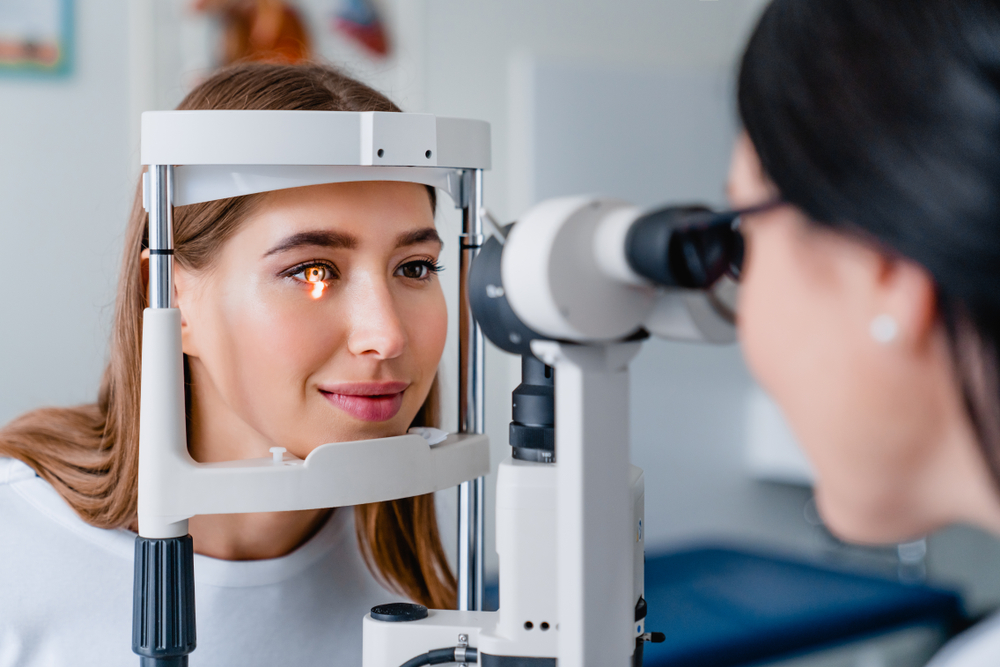
Regular comprehensive eye exams are important for all patients. However, this is especially true if you suffer from diabetes. This is because patients who have diabetes are at greater risk of developing a group of eye problems that are collectively known as diabetic eye diseases.
Diabetic eye diseases occur when the persistently high blood sugar levels of someone with diabetes causes damage to the eyes. This can happen in a variety of ways, from triggering swelling and inflammation and causing the pressure inside the eyes to rise significantly, to damaging the blood vessels responsible for keeping our eyes healthy. There are a number of diabetic eye diseases including diabetic retinopathy, diabetic macular edema, cataracts, and glaucoma.
Symptoms of Diabetic Eye Diseases
Most instances of diabetic eye diseases develop slowly over months or years, meaning that symptoms also develop equally as gradually. When they do become noticeable, they can include blurred vision, poor color vision, difficulty seeing details, spots/floaters, and total vision loss. If you are diabetic and you experience any issues with your vision, don’t delay speaking to your eye doctor.
Diagnosing Diabetic Eye Diseases
One of the most effective ways of diagnosing diabetic eye diseases is to ask patients to undergo a specific type of exam called an OCT exam. OCT stands for Optical Coherence Tomography.
OCT testing is similar to an ultrasound, although instead of using sound waves it uses light o pass through the eye in order to capture 3D, cross-sectional images of the back of the eye. These high-resolution images will provide your eye doctor with an opportunity to assess the condition of the structures of the very back of your eye, checking for any abnormalities that could indicate diabetic eye diseases, such as swelling of the retina or bleeding blood vessels.
OCT scans are short and painless since they are entirely non-invasive. Patients are first given dilating eye drops which enlarge the pupil so that it is simpler for your eye doctor to look through them to the very back of the eye. The actual scan is carried out in the seated position, with your chin and head rested against the OCT machine. The scan will take around 20 seconds, during which time you will be asked to stare into the small, blinking target you will see in the lens of the machine. Afterward, there’s no downtime although your eyes may be a little sensitive to light for a few hours.
Treatment for Diabetic Eye Diseases
Precisely which treatment for diabetic eye disease you will be recommended will depend on exactly which condition you are being affected by. Unsurprisingly, the first thing that your eye doctor will recommend will be to take steps to get your diabetes under control. Managing it properly is crucial if you are to prevent any further deterioration in your vision or developing any more issues linked to your blood sugar levels.
Diabetic eye diseases usually only require specific treatment when they are advanced enough to be a threat to your vision. Some of the treatments for advanced diabetic eye diseases include:
Laser treatment: laser technology is used to treat the growth of new blood vessels at the back of the eye. It is necessary because the new blood vessels tend to be weak and cause bleeding into the eye that impairs your vision. Laser treatment is carried out using local anesthetic eyedrops which are placed into the eyes before the procedure. Once your pupils are dilated, special contact lenses are used to hold your eyelids open so that the laser can focus on the retina. The process takes between 20 and 40 minutes, and some patients may need more than one treatment.
Injections: placed directly into the eyes, these injections are designed to treat severe maculopathy by preventing new blood vessels from forming at the back of the eye. The medicine used to do this is called an anti-VEGF. Before your injections, numbing medicine will be placed onto your eyes to keep you feeling as comfortable as possible during the procedure. After the treatment, you may need to use antibiotic eye drops to keep your eyes from developing an infection. If your eye doctor recommends anti-VEGF injections, you will likely be given a series over a number of months to see how your eyes respond. In some cases, patients may be reliant on keep getting injections to protect their vision.
Lens replacement surgery: if you are experiencing cataracts as a result of your diabetes, the only way to restore your vision is to undergo lens replacement surgery. This is where the natural lens of the eye that has become clouded by cataracts is removed and replaced with an artificial lens. There are various different lenses to choose from, and your eye doctor will help you to find the variety that will best support your vision.
For more advice on diabetic eye diseases, don’t hesitate to get in touch with our knowledgeable eye care team.








